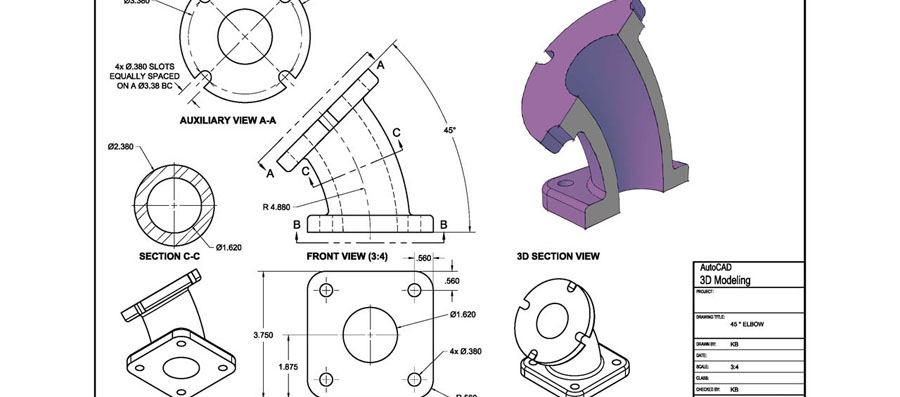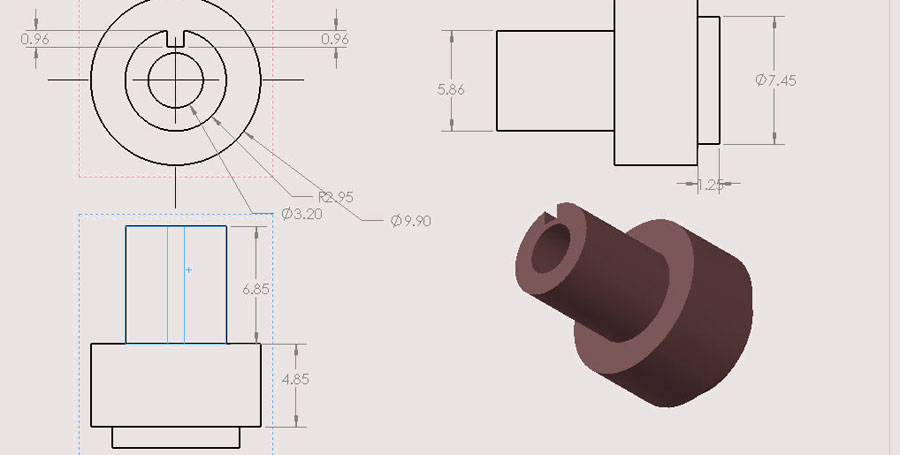3D files have changed the way engineers work with manufacturers. Engineers can now design parts using CAD software, send digital files to manufacturers, and have manufacturers manufacture parts directly from the files using digital manufacturing techniques such as CNC machining.
But while digital files have made manufacturing faster and easier, they have not completely replaced the art of drafting, the creation of detailed, annotated engineering drawings. 2D drawings are often viewed as a time-consuming, zero-value-added step in the manufacture of custom engineered components. However, many engineers don’t realize that a 2D part drawing is arguably the most important step in designing an assembly. 2D drawings convey information that is difficult, messy, or even impossible to express in a 3D environment.
Since the digital 3D model must communicate the shape and size of the part, it appears that 2D drawings are no longer required. In a sense, this is true: Engineers can use CAD software to design parts, and the same digital file can be sent to a machine for fabrication without anyone having to pick up a pencil.
However, that doesn’t tell the whole story, many manufacturers like to receive 2D drawings and CAD files when making parts for their customers. 2D drawings follow common standards. They are easy to read, can be handled in a variety of settings (unlike a computer screen), and clearly emphasize critical dimensions and tolerances. In short, manufacturers still use the language of 2D technical drawings.
Complement CAD files with 2D drawings. By creating both, you can provide manufacturers with the clearest picture of requirements, reducing the chance of miscommunication.

Why 2D Drawing Is Important
There are several reasons why 2D drawings remain an important part of the manufacturing workflow.
Reduce Design Errors
Drawings are very helpful to part designers. They force engineers to review their parts from multiple angles and can lead to the identification of design errors that go unnoticed in the 3D environment. Drawings also serve as a concise, compact form of design revision history for other engineers on the team to use.
Portability
Printed 2D technical drawings can be easily moved, shared and read in a variety of environments. Viewing 3D models on a computer screen is useful for manufacturers, but probably not every machining center or post-processing station has a monitor next to it.
Familiarity
While all manufacturers are familiar with CAD, there are differences between the different digital formats. Drafting is an established technique and the standards and symbols used on 2D drawings are recognized by all in the industry. Additionally, some manufacturers can evaluate 2D drawings (for example, to estimate the cost of a quote) faster than a digital model.
Critical Tolerance
If you have a ½” hole in your part. Is it a through hole for a ½” bolt? Or a close-tolerance hole for a ½” bearing? If any of these are falsely assumed, your part is scrap, or leads to costly rework, project delays, or additional costs. Accurate 2D drawings can easily eliminate this risk.
At the same time, if a relatively tight standard tolerance (eg 0.010mm) is specified on a part with a 3D file, the machinist must ensure that every dimension/feature is machined to that tolerance, which can become very expensive.
The cost of a part can be reduced if you create 2D drawings with tight and loose tolerances for increasingly important and less important features, respectively.

Faster Lead Times
This is much faster than using CAD software to open files, measure critical dimensions and quote. Faster quotes translate into faster manufacturing lead times, allowing us to get your parts to you as quickly as possible!
Good For Quality Control
2D drawings provide a simple reference to the tolerances that critical dimensions need to meet, how parts are assembled, and important checkpoints for parts, and are important reference documents for quality control.
Conclusion
In our experience, customers who provide 2D drawings and 3D part files experience fewer design errors, get parts faster, and are more satisfied with the parts they receive. The time saved by the above 2D drawings far outweighs the time and money lost due to rework and project delays due to expected miscommunication.



